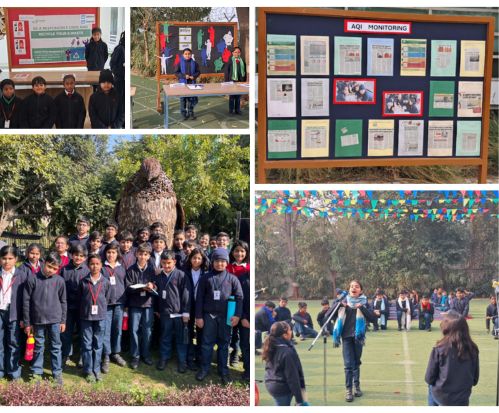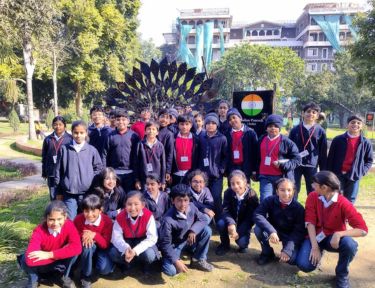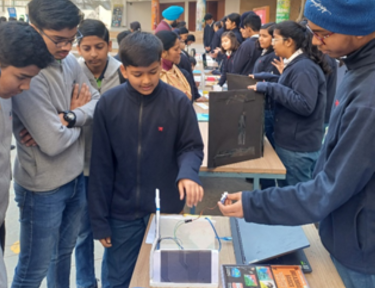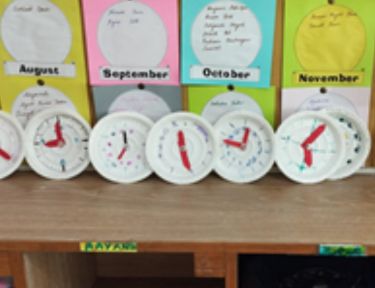


THE EARTH OF OUR DREAMS
About the project
The primary objective of the project was to foster critical thinking, collaboration, and problem-solving skills among students while addressing real-world environmental concerns. The project sought to empower students of class V to become informed and proactive agents of change in combating pollution.
Driving Question
What would your dream Earth look like?
Process
The driving question ignited curiosity, and with the context of rising air pollution and AQI, the project began with the selection of the topic ‘Pollution’, which is also the content of the Chapter ‘Our Environment’. The project started with AQI Monitoring, in which the AQI for three weeks in the month of December was monitored from newspaper reports and analysed. Thereafter, the following steps were followed.
Group Formation—To encourage collaboration, Students were organised into 5 groups, each with different roles and responsibilities as researchers, interviewers, and scriptwriters.
Research and Investigation: Groups conducted extensive research on different forms of pollution, including air, water, and land pollution. They explored the causes, sources, effects, and potential solutions for each type of pollution through case studies and Friday Projects.
Data Collection and Analysis: Students collected data from various sources, including newspapers and community surveys. They analysed the data to identify trends, patterns, and significant findings related to pollution.
Problem Identification: Through research and analysis, groups identified specific pollution problems within their immediate local community and school. They considered factors such as pollution hotspots and peoples’ viewpoints.
Reaching out to the community: We decided to reach out to the community through Street Play or Nukkad Natak about the challenges of pollution. Students wrote their own scripts on the theme of Kal, Aaj, and Kal during the journey.
Interdisciplinary: The project involved the following interdisciplinary elements:
- Theatre – Nukkad Natak (Street Play)
- Math – Data Analysis of AQI through Bar Graph
- English – Letter writing to the RWA secretary
- Computer – Creating online survey forms for the interview
Interactive Session with Atithi: Dr. Aprajita from NAMO Waste Management Ltd. conducted a talk session on e-waste management to educate children about the impact of electronic waste on the environment, the importance of recycling, and proper disposal methods from a young age. The session was beneficial for raising awareness about environmental issues and responsible waste disposal.
During the talk session, the following topics were discussed:
- What is e-waste?
- The environmental impact of e-waste, including pollution of soil and water, as well as the release of harmful chemicals and toxins.
- The importance of recycling electronic devices and how materials from old electronics can be reused to create new products.
- Proper disposal methods for e-waste, including recycling centres, donation programs, and electronic waste drop-off locations.
- Interesting facts and data about e-waste to understand the scope of the problem and the importance of taking action.
The talk session was followed by an e-waste collection drive, for which the whole school was notified through a circular urging them to dispose of their e-waste in the e-waste bin placed on the School campus.
Conducting a talk session on e-waste management for the students helped instill important values of environmental and sustainability from a young age, empowering them to make informed choices and take action to protect the planet.
Field Trip: We visited the ‘Waste to Art Park’ at Chanakyapuri. The students were briefed about the context of waste management and environmental sustainability. During the visit, the students learned about various aspects related to waste management and about creative reuse of waste materials. This trip helped raise awareness about the importance of waste reduction, recycling and upcycling.

Project Culmination
The project culminated with a powerful performance by the students through self-scripted ‘Nukkad Natak’ (street play), which was well implemented. Their thoughts and feelings reached out to the community of parents and the Natak was well appreciated by one and all.
.
Teacher Reflection
This project was a very well-graded transition from PowerPoint to the power of students’ voices. One of the highlights of the project was the level of engagement it generated among the students. The hands-on nature of the activities and the real-world relevance of the project topic captured their interest and motivated them to participate actively at all times. The project provided ample opportunities for students to collaborate and work as a team.
I was impressed by their ability to think creatively and adapt their approaches when faced with obstacles.
Overall, the project was a valuable learning experience for both the students and me. By reflecting on the strengths and areas for improvement, I am confident that future projects will be even more successful in fostering student growth and development.
















